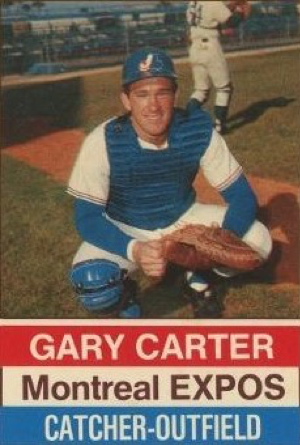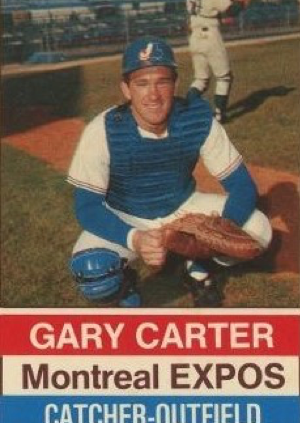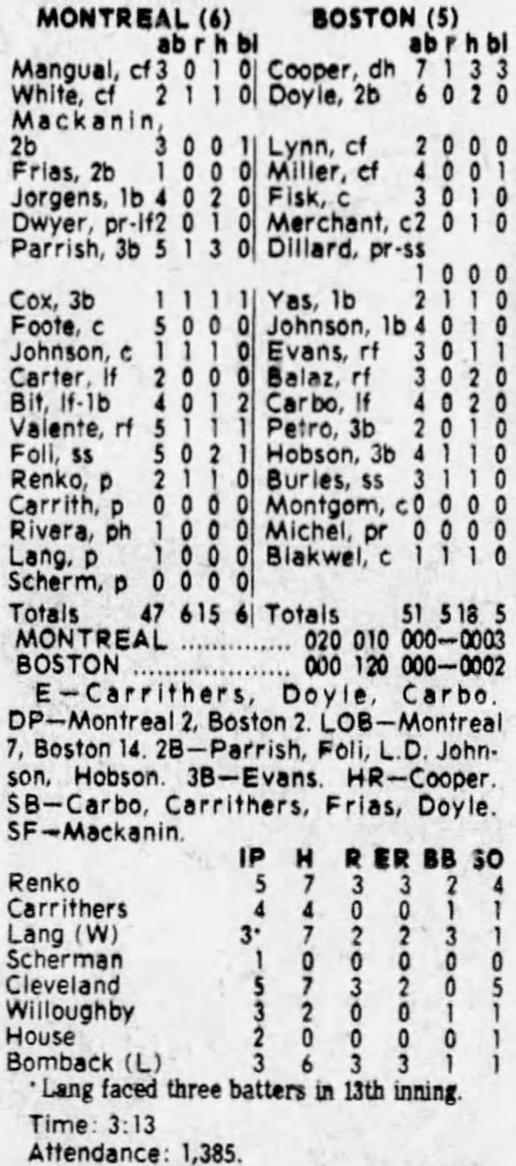April 1, 1976: Gary Carter cut for 16 stitches after slamming into cement outfield wall
 Gary Carter had been The Sporting News’ National League Rookie Player of the Year in 1975.1 He was the Montreal Expos’ sole representative at the 1975 All-Star Game and the recipient of the team’s Player-of-the-Year Award.2 But despite all of the accolades, Carter went into spring training in 1976 battling for playing time at catcher with the highly touted Barry Foote.
Gary Carter had been The Sporting News’ National League Rookie Player of the Year in 1975.1 He was the Montreal Expos’ sole representative at the 1975 All-Star Game and the recipient of the team’s Player-of-the-Year Award.2 But despite all of the accolades, Carter went into spring training in 1976 battling for playing time at catcher with the highly touted Barry Foote.
Although Carter was happy to play both the outfield and catcher to get more at-bats,3 his boundless enthusiasm on the diamond wasn’t a great fit for the outer garden. “Carter played outfield like a bull in a china shop,” recalled his longtime batterymate Steve Rogers.4 A prime example of that approach came in a relatively meaningless spring-training game on April 1, 1976, when Carter – still one week shy of his 22nd birthday – sprinted after a fly ball and crashed face-first into an unpadded cement wall. The mishap sent him to the hospital for 16 stitches,5 although it could have been much worse; it could have derailed his Hall of Fame career.
The Expos had selected Carter in the third round of the June 1972 amateur draft out of Sunny Hills High School in Fullerton, California.6 He rocketed through Montreal’s minor-league system in just three years, making his major-league debut in September 1974. At the time of his call-up, he had played 256 professional games at catcher and only three in the outfield.
Foote, taken third overall in the June 1970 draft, made his big-league debut in September 1973 and was named to the Topps All-Star Rookie Team the next season. To get both youngsters into the lineup, Carter split his time between the outfield and catcher in 1975 and Foote served as the Expos’ primary backstop. That season Carter played 92 games in right field and 66 games behind the plate.
Montreal Gazette sportswriter Ian MacDonald immediately saw the danger in the Expos’ strategy. “Some afternoon or evening this summer, Gary Carter is going to crash head first into an outfield fence,” he wrote on April 18, 1975. “The way in which Carter plays the game suggests that he’ll meet an immovable object somewhere along the way.”7 The hard-nosed rookie didn’t seem to care. “I’m not going to worry about fences,” he said. “My job is to catch the ball.”8
The very next day, Carter injured himself patrolling right field against the Philadelphia Phillies.9 With the Expos trailing by three runs in the fifth inning, he made a leaping grab to rob Dave Cash of a solo home run, landing on Parc Jarry’s five-foot-high wire fence and cracking two ribs.10 He spent a night in hospital but missed only two games.
A 17-day lockout at the beginning of March 1976 delayed the opening of spring training, resulting in an abbreviated spring schedule. With just one week of exhibition play remaining, Montreal came into its April 1 game against the defending American League champion Boston Red Sox with a 4-4 record.11 Boston had compiled a 6-2-1 mark.12
Reggie Cleveland, whose 4-0 record and 2.21 ERA the previous September had helped clinch the American League East Division title, got the start for Boston. The Moose Jaw, Saskatchewan, native tossed a scoreless first inning before Montreal touched him for a pair of runs in the second on RBIs by rookie right fielder Ellis Valentine and veteran shortstop Tim Foli.13 (Carter was stationed in left field despite never having played a single regular-season game in the big leagues at that position.)
Expos starter Steve Renko kept Boston off the scoreboard in the first three innings.14 After Carl Yastrzemski singled in the fourth, Dwight Evans hit a long fly ball to left field and Carter took off in pursuit.15 “I think I had the ball,” recalled Carter. “I looked in my glove and it was there, but I took my eyes off the wall and hit face first.”16
But Carter was unable to hold on after hitting the wall. He turned around, picked up the ball and tossed it in the direction of Foli. Carter took one step backward and then crumpled to the ground.17 “I saw blood and collapsed,” he said. “I don’t know if I passed out. I remember Tim Foli telling me to lie down.”18
Yastrzemski scored on the play and Evans pulled into third with a triple.
The gruesome incident quieted the 1,385 fans at Chain O’Lakes Park. “The lasting impression of an otherwise dull afternoon was the echo of a cracking splat against the left-field wall,” wrote Peter Gammons in the Boston Globe. “The echo of that cracking splat won’t leave the ears of anyone who heard it for a while.”19
Carter was wheeled from the field on a stretcher and taken to Winter Haven Hospital by ambulance. He needed 16 stitches to close the gash in his forehead, yet he was able to rejoin his teammates at the ballpark later in the afternoon.20
In the fifth inning, another Expos rookie, Jerry White, scored on Pete Mackanin’s sacrifice fly, giving Montreal a 3-1 lead. (The Expos had the youngest position players in the majors for the second straight season.)
In the bottom of the inning, Renko surrendered a two-run homer to Cecil Cooper and the game was tied, 3-3. The starting pitchers departed after the fifth and both bullpens did yeoman’s work, tossing seven consecutive scoreless innings.21
Boston’s Mark Bomback, a starter in Triple A for all of 1976, ran into trouble in the 13th, his third inning of work. White led off with a single, moved to second on a sacrifice by the light-hitting Pepe Frías, and scored on Jim Cox’s single.22 Larry Doby Johnson, who was named after Larry Doby, the AL’s first Black player and the Expos’ hitting coach, doubled to advance White to third.23 Both baserunners came home on Larry Biittner’s single and the Expos led 6-3.
The insurance runs came in handy in the bottom of the inning. Rookie Chip Lang – starting his fourth inning on the mound − allowed the first three batters to reach base. After an RBI single by Cooper, he was replaced by veteran lefty Fred Scherman.24 The Red Sox could score only one more run on an RBI groundout by Rick Miller and Scherman picked up the save in a 6-5 Expos victory.
Montreal general manager Jim Fanning expressed concern for the safety of outfielders at Boston’s spring-training facility. “[Carter] could have been seriously injured,” said Fanning. “I imagine with their own stars, such as Fred Lynn, they’ll think about padding that wall before next spring.”25 The previous fall, Lynn had injured himself running into the center-field wall at Fenway Park in Game Six of the World Series, and the Red Sox promptly added padding in the offseason to prevent further injuries.26 But the outfield wall at Chain O’Lakes Park remained unpadded until February 1979 when the city of Winter Haven and the Red Sox agreed to split the cost.27
Carter took a few days off and resumed baseball activities on April 5. After his initial workout, he had to lie down and rest because of dizziness.28 True to his bulldog mentality, Carter was back in the lineup as Montreal’s Opening Day right fielder at Shea Stadium on April 9. He appeared in each of the Expos’ first 43 games and in 26 of those contests he was the starting catcher.
Carter suffered another outfield mishap on June 6 when he broke his thumb in a collision with center fielder Pepe Mangual.29 Carter was out of action for six weeks, and he struggled when he returned. He hit only .199 − with little power − for the remainder of the season.
The Expos finished in last place in the NL East with a record of 55-107, only three games better than their inaugural season of 1969. Injuries, slumps, and clashes between veteran players and 38-year-old rookie manager Karl Kuehl, who was fired on September 4, all contributed to a disastrous campaign.30 The team was also overshadowed by the Montreal Summer Olympics, and attendance dropped 29 percent to 646,704, second worst in the majors.31
But the combination of Foote’s second consecutive poor season at the plate, Carter’s continued misadventures in the outfield, and Kuehl’s removal as manager led to a change of heart by the Expos’ brain trust. In the fall of 1976 Carter was quietly told that he would never again play regularly in the outfield.32
One day before the 1977 season opened, new Expos manager Dick Williams announced that Carter was the team’s full-time catcher33 and on June 15 Foote was traded to the Phillies.34 Carter responded with a breakout season, hitting .284 with 31 homers and 84 RBIs. He amassed 5.4 Baseball-Reference Wins Above Replacement (bWAR), tops among NL catchers. As measured by bWAR, it was the first of nine consecutive seasons in which Carter was the league’s best catcher.
Acknowledgments
This article was fact-checked by Kurt Blumenau and copy-edited by Len Levin.
Sources
In addition to the sources cited in the Notes, the author consulted Baseball-Reference.com and Retrosheet.org. The author also reviewed the SABR biographies of Gary Carter and Barry Foote. Unless otherwise noted, all play-by-play information for this game was taken from the article “Carter Cut for 15 Stitches After Smashing into Wall,” on page 22 of the April 2, 1976, edition of the Montreal Gazette.
Neither Baseball-Reference nor Retrosheet provides box scores of spring-training games. The image of the box score for this game (shown below) was taken from the Montreal Gazette.
Photo credit
Photo of Gary Carter downloaded from the Trading Card Database.
Notes
1 Bob Dunn, “‘Bench-Type’ Carter Picked Top N.L. Rookie,” The Sporting News, October 25, 1975: 7. Carter won NL Rookie Player of the Year in a poll of players conducted by The Sporting News after hitting .270 with 17 homers and 68 RBIs. He finished second behind John Montefusco in NL Rookie of the Year voting by the Baseball Writers’ Association of America. Montreal third baseman Larry Parrish tied for third place.
2 Carter replaced Pete Rose in left field in the ninth inning of the 1975 All-Star Game, catching the final out in a 6-3 National League victory. Canadian Press, “Expos Carter Looks for Even Better Season,” Saskatoon (Saskatchewan) Star-Phoenix, April 2, 1976: 26.
3 Canadian Press, “Expos Carter Looks for Even Better Season.”
4 Jonah Keri, Up, Up & Away: The Kid, The Hawk, Rock, Vladi, Pedro, Le Grand Orange, Youppi!, The Crazy Business of Baseball, & the Ill-fated but Unforgettable Montreal Expos (Toronto: Random House Canada, 2014), 76.
5 The author found newspaper accounts describing 13, 15, and 16 stitches. Peter Gammons of the Boston Globe reported 16 stitches. An Associated Press wire story quoted Expos general manager Jim Fanning as saying that Carter needed 13 outer and 3 inner stitches. Peter Gammons, “Expos Edge Sox, 6-5, in 13th; Carter KO’d by Cement Wall,” Boston Globe, April 2, 1976: 32; Associated Press, “Carter Gets 16 Stitches,” Lewiston (Maine) Daily Sun, April 2, 1976: 21.
6 Carter had been primarily a shortstop in high school, although he also played several games at catcher. The Expos immediately converted him to a full-time catcher after selecting him in the 1972 draft. Keri, 72-73.
7 Ian MacDonald, “The Expos: As Usual There’ll Be Fumbles and There’ll Be Errors but the 1975 Version Is a Team with a Difference,” Montreal Gazette, April 18, 1975: 15.
8 MacDonald, “The Expos: As Usual There’ll Be Fumbles and There’ll Be Errors but the 1975 Version Is a Team with a Difference.”
9 Carter did not start a game at catcher until May 12. Foote was hitting just .107 at the time.
10 Initial reports indicated that Carter cracked only one rib, but a second one was diagnosed later. Bob Dunn, “What’s Up Doc? Carter OK, Bailey Fair, Coggins −?” Montreal Star, April 21, 1975: C-1; “Bailey Fit; Carter Not,” Montreal Star, April 26, 1975, H-2.
11 “Exhibition Schedule Standings,” Boston Globe, April 1, 1976: 38.
12 Gammons, “Expos Edge Sox, 6-5, in 13th.”
13 The RBIs by Valentine and Foli were deduced from the box score. The Tampa Tribune reported that Pete Mackanin knocked in a run with a sacrifice fly in the fifth inning. According to the Montreal Gazette, Jim Cox knocked in a run and Larry Biittner drove in the other two in the 13th inning. Myron Hart, “Parrish Aids Expos Victory,” Tampa Tribune, April 2, 1976: 8.
14 Renko had been an Expos stalwart since he was acquired on June 15, 1969, as part of the trade that sent Donn Clendenon to the New York Mets. On May 17, 1976, the Expos traded Renko and Larry Biittner to the Chicago Cubs for Andre Thornton. Renko signed as a free agent with the Red Sox in January 1979. He went a combined 20-18 with a 4.15 ERA in two seasons in Boston.
15 United Press International, “Red Sox Lose in 13th,” Lynn (Massachusetts) Daily Item, April 2, 1976: 17.
16 Ian MacDonald, “Carter Cut for 15 Stitches After Smashing into Wall,” Montreal Gazette, April 2, 1976: 22.
17 Gammons, “Expos Edge Sox, 6-5, in 13th; Carter KO’d by Cement Wall.”
18 MacDonald, “Carter Cut for 15 Stitches After Smashing into Wall.”
19 Gammons, “Expos Edge Sox, 6-5, in 13th; Carter KO’d by Cement Wall.”
20 Associated Press, “Carter Gets 16 Stitches.”
21 Montreal’s seven scoreless bullpen innings came from Don Carrithers (innings six through nine) and Chip Lang (innings 10 through 12). Boston’s scoreless frames came from relievers Jim Willoughby (innings six through eight), Tom House (innings 9 and 10), and Mark Bomback (innings 11 and 12).
22 “Carter Injured, Expos Outfox Sox,” Montreal Star, April 2, 1976: C-1.
23 Johnson relieved Foote at catcher in the late innings. He was born in Cleveland on August 17, 1950, approximately three years after Doby made his American League debut with the Cleveland Indians. Johnson was selected by the Indians in the ninth round of the June 1968 amateur draft. He appeared in just 12 games in his brief major-league career, seven of which were with the Expos in 1975-76.
24 United Press International, “Red Sox Lose in 13th.”
25 “Carter Injured, Expos Outfox Sox.”
26 Video of Lynn hitting the outfield wall can be found on YouTube. He remained in the game after the incident and played all 12 innings of the legendary Game Six, which the Red Sox won on Carlton Fisk’s dramatic walk-off home run.
27 Larry Whiteside, “Red Sox Notebook; Sullivan Is Busy,” Boston Globe, February 28, 1979: 40.
28 “Ol’ Woodie Fries the Royals, 6-0,” Montreal Star, April 6, 1976: 28.
29 Bob Morrissey, “Expos Lose Game – and Carter for 6 Weeks,” Montreal Gazette, June 7, 1976: 21.
30 Aside from the Carter injury, the Expos suffered a major setback when their ace, Steve Rogers, broke a bone in his pitching hand on May 25 and missed just over a month. Gary Belleville, “June 26, 1976: Pirates Slip Past Expos despite Bombo Rivera’s Inside-the-Park Grand Slam,” SABR Games Project, https://sabr.org/gamesproj/game/june-26-1976-pirates-slip-past-expos-despite-bombo-riveras-inside-the-park-grand-slam/, accessed April 3, 2024.
31 The San Francisco Giants (626,868) had the worst attendance in the majors in 1976. The Expos moved into Olympic Stadium in 1977. Despite finishing with a losing record for the ninth straight season, attendance rebounded to 1,433,757, sixth best in the NL.
32 Bob Dunn, “Carter Rated No. 1 on Gary and Barry Show,” Montreal Star, March 26, 1977: G-1.
33 Ian MacDonald, “Williams Analyzes Team,” Montreal Gazette, April 9, 1977: 13.
34 The Expos traded Foote and pitcher Dan Warthen to the Phillies for backup catcher Tim Blackwell and pitcher Wayne Twitchell. Foote finished his 10-year major-league career in 1982 with a .230 batting average, 57 homers, and 230 RBIs.
Additional Stats
Montreal Expos 6
Boston Red Sox 5
Chain O’Lakes Park
Winter Haven, FL
Corrections? Additions?
If you can help us improve this game story, contact us.



